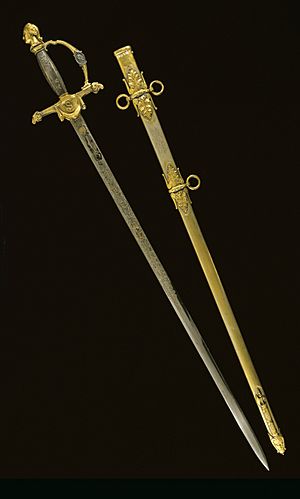John Dunlap Stevenson facts for kids
Quick facts for kids
John Dunlap Stevenson
|
|
|---|---|
| Born | June 8, 1821 Staunton, Virginia |
| Died | January 22, 1897 (aged 75) St. Louis, Missouri |
| Buried |
Bellefontaine Cemetery, St. Louis, Missouri
|
| Allegiance | United States of America Union |
| Service/ |
United States Army Union Army |
| Years of service | 1846–1847, 1861–1870 |
| Rank | |
| Commands held | 7th Missouri Infantry Regiment 3rd Brigade, 3rd Division, XVII Corps 30th U.S. Infantry Regiment |
| Battles/wars | Mexican–American War American Civil War |
| Other work | Law |
John Dunlap Stevenson (born June 8, 1821, died January 22, 1897) was an American lawyer, politician, and soldier. He fought in two wars for the U.S. Army. During the American Civil War, he became a brigadier general. Later, he was recognized as a brevet major general.
Contents
Early Life and Career
John D. Stevenson was born in Staunton, Virginia, on June 8, 1821. He went to the College of South Carolina. In 1842, he started working as a lawyer in Franklin County, Missouri.
Service in the Mexican-American War
Stevenson joined the 1st Missouri Mounted Volunteers on June 27, 1846. He served as a company commander during the Mexican–American War. His unit was part of Brigadier General Stephen Kearny's invasion of the New Mexico Territory. Stevenson left the volunteer service on June 24, 1847.
Political Life in Missouri
After the war, Stevenson became a member of the Missouri state legislature. Even though he was born in Virginia, he strongly supported the Union cause. This was important as the Civil War approached.
Military Service in the Civil War
Stevenson joined the Union Army as a colonel. He led the 7th Missouri Volunteer Infantry Regiment. He soon took temporary command of larger groups of soldiers called brigades. These brigades were part of the Army of the Tennessee.
Becoming a Brigadier General
On March 13, 1863, President of the United States Abraham Lincoln made Stevenson a brigadier general. This rank was effective from November 29, 1862. The United States Senate confirmed his appointment. Stevenson briefly left the army in April 1864. However, he rejoined in August 1864 with his previous rank. He then served in the Department of West Virginia.
Role in the Vicksburg Campaign
Stevenson commanded the 3rd Brigade, 3rd Division, XVII Corps. This group was known as the "Irish Brigade." They played a key role in the Vicksburg Campaign.
He is most famous for leading a charge at the Battle of Champion Hill. This attack broke the Confederate army's left side. For his bravery at Champion Hill, he was later recognized as a brevet brigadier general in the regular army. Stevenson also took part in the Siege of Vicksburg. This included the famous mine explosion at Vicksburg. After Vicksburg, he commanded the District of Corinth.
Later Promotions and Retirement
Stevenson left the volunteer army on January 15, 1866. On February 24, 1866, President Andrew Johnson nominated him for brevet major general. This rank was effective from March 13, 1865. The United States Senate confirmed this promotion.
On July 28, 1866, Stevenson became a colonel in the Regular Army (United States). He was put in charge of the 30th U.S. Infantry Regiment. He was later assigned to the 25th U.S. Infantry. Stevenson left the regular army on December 31, 1870. After leaving the army, he went back to working as a lawyer.
Later Life and Legacy
John D. Stevenson passed away in St. Louis, Missouri, on January 22, 1897. He was buried at Bellefontaine Cemetery in St. Louis.
Images for kids
-
Bronze relief portrait of Stevenson by T.A.R. Kitson at Vicksburg National Military Park



